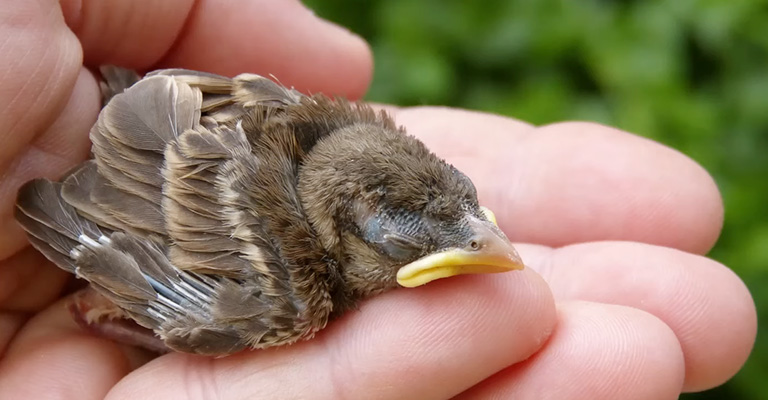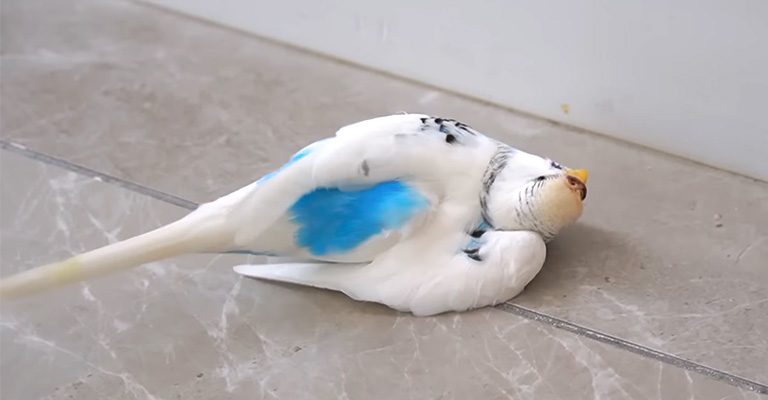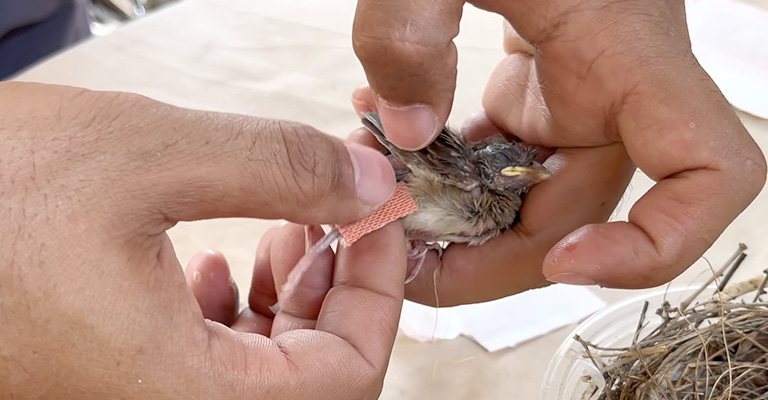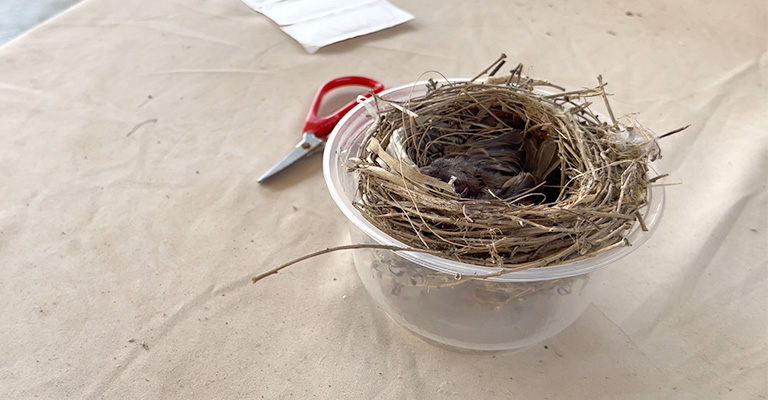If you are a bird lover or budgie owner, you simply can’t ignore a scared little bird on the ground if you have found yourself in a situation where you found a bird on the ground and don’t know what to do.
Don’t worry; you are not alone! There are many people who find themselves in the same situation and don’t know how to save a dying bird.
If you are worried that the bird is going to die, with a little effort, you might be able to save its life. So, in this post, I will teach you how to save a dying bird without wasting time.

How to save a dying bird?
To save a dying bird, there are some steps that you need to follow. Here in this article, I have made it easy for you so that you can save the life of the little birdie.
Detect the bird if it’s fledgling or nestling.
If it’s a baby bird that appears to be injured or distressed, you might just want to help it as your instinct. But you need to first determine if it’s a fledgling or nestling.
Nestlings are typically born blind, naked, and they are helpless. They usually stay most of their nest and are even fed by their parents. On the other hand, fledglings are young birds that did leave the nest but are not able to fly well.
They generally have a feather thatch that has not been fully grown yet. So fledglings are covered in feathers, and even if they can move on their own, they still rely on their parents for food. Now that you have figured out what type of bird it is, let’s go to the next step.
Determine How Much the Bird is Injured

In some cases, the bird might be cold and wet, and it might just need warmth and shelter. But in case the bird has broken bones or any visible wounds, it requires intensive treatment.
Once you can determine the level of injuries, you can now take steps to save the birdies life. If the injuries are minor, you might be able to do it yourself.
But if the injuries are serious, you will need to take the bird to a qualified wildlife rehabilitator for treatment. By taking quick action, you can give the injured bird a chance to survive and let it return to the wild.
Notice if the Parents or Nest is Nearby
While you might really want to take care of the birdie and take it home and care for it yourself, remember, wild baby birds are best if they are cared for by their parents and are in their nest.
In this type of situation, what you can do is leave the bird where you found it and observe from a distance if its parents are nearby.
If, even after some time, you can’t determine if your parents are nearby, but you notice the nest, you can try to gently place the bird back in its nest.
How to Care for an injured bird

If you don’t find the nest or see the parents return near the baby bird in a few hours, and if the baby birdie appears to be injured, you need to take some necessary precautions. Here are some simple steps that will help you recover the injured birdie.
Take Safety Precautions
First things first! Even if you are trying to save the injured bird, wear gloves so that you don’t get sick or infected. This will protect you from diseases.
Birdies can carry different kinds of viruses and diseases that would make you sick. And so before you do anything, wear a pair of gloves. Once you have the gloves on now, you can pick up the injured bird.
As a precaution, always wash your hands after you handle any type of fowl.
Keep It Warm and Cozy
Baby birds, especially nestlings, cannot regulate the temperature of their body, so they easily become too cold. You can wrap the bird in a soft towel or cloth or keep it in a shoe box. But before, line the shoe box with a towel.
If you need further heat, you can also put a heating pad underneath the box. All you need to do is be sure that the bird has enough ventilation so that it can move away from heat whenever it feels too warm.
Make a Makeshift Temporary Nest

After you find an injured bird, the first thing you will need to do is make a temporary nest. This temporary nest will keep the birdie warm and cozy even while you are taking it to the wildlife rehabilitation center. To make the nest
Once you are done with the nest, find a plastic container, basket, cardboard box, or other materials that could be used as a nest.
Now make the walls of the box shorter than the baby bird. Drill holes on all the sides of the box to keep the baby ventilated.
To provide comfort to the injured birdie, make sure to put tissue, towel, or straw on all sides of the box and on the base. While doing so, make sure that you are not blocking all the ventilation holes.
While building a temporary nest, make sure you are not using any kind of slippery materials that come with large holes. Those items are risky for the baby nestlings as they could slip in them, or their legs could get stuck in the holes.
Find a Safe Spot for the Nest
Once the nest is ready and you have placed the baby bird in it, find a safe and secure space for the nest. You can preferably keep it in a flat tree branch. Or you could also use other spots from your backyard.
No matter where you intend to place the nest, just make sure that it’s safe and secure. There should not be any predators, pets, or noisy children that could reach the injured birdie.
If it’s possible, try to make a temporary nest near the spot where you found your fledgling or nestling. The goal should be that the bird’s parents could find its babies.
Keep Providing Food and Water
It’s usually the responsibility of the parents to feed the young nestlings and fledglings, but since the parents are not nearby, the duty falls on you.
That’s to revive the baby bird from the weakness, you might also need to feed the nestling with different types of insects, maybe earthworms, or you could also feed bird seeds to the fledgling.
Keep an open water container for the fledgling with little water so that it can keep itself hydrated but not drown in it. But the nestlings, they cannot drink the water on their own, so use a dropper or syringe without the sharp part to feed water.
Also, be cautious about not leaving a bunch of food at a time inside the nest, as doing so would allow the young bird to eat all of it together, which would cause more harm than good. What you need to do is provide a baby bird with a small amount of food from time to time.
Monitor the Nest and Its Habitat
After you have rescued the baby bird and even transferred it to a temporary nest, keep an eye on it. Let some hours pass so that the parents can find their young ones.
Also, in the mean, keep watching over the birdie so that no harm comes to it. If there are any predators nearby, make sure to shoo them away and also keep the naughty and curious kids away, as these could spook the parents of the baby bird.
Keeping an eye on the bird could take hours and even days. The important thing is you need to watch over the little birdie you rescued, at least until the little creature is recovered and strong and stable enough that it can fly.
Inform a Licensed Wildlife Animal Rehabilitator
Even after all your efforts, it might not be enough to save the nestling or fledgling, but as you are not a professional rescuer. It’s ideal to call and contact a local licensed animal rehabilitator and report to him or her everything that is going on.
Nestlings and fledglings are vulnerable in many ways, especially if they are wounded severely. So, even if you have done all that you could to save the little one, you cannot watch and keep an eye on it for a long time.
If you have no idea about the local wildlife rehabilitator near you, use the internet and inform us of everything you have done with the birdie so far.
Then leave the birdie as it is or wait for a professional wildlife rehabilitator to come and take care of it so that you can go on your own.
How to save a dying bird? : Winding Up
The steps on how to save a dying bird are quite simple and yet complex if you do not follow them properly.
By following these easy steps, you can safely and easily rescue the injured bird, whether it’s a nestling or fledgling. By making a makeshift nest and feeding the birds from time to time, you are saving the little creature.
But never forget that injured birds are better off with a licensed wildlife rehabilitator, so whenever you find a severely injured baby bird, make sure to call the wildlife rehabilitator.
I hope you learned how to save a dying bird from this article. If you have a story about saving a birdie, do share it with us in the comment section.